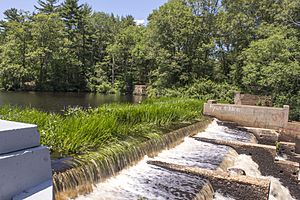Indian Head River facts for kids
Quick facts for kids Indian Head River |
|
|---|---|

The dam and fish ladder at the Indian Head River reservoir.
|
|
| Physical characteristics | |
| River mouth | 3 ft (0.91 m) |
| Length | 3.7 mi (6.0 km) |
The Indian Head River is a small but important river in Massachusetts. It starts where the Drinkwater River (in Hanover) and Indian Head Brook (in Hanson) meet. The river then flows east, forming part of the border between Hanover and Pembroke.
This river is about 3.7 mi (6.0 km) long. It flows into the North River, which then empties into Massachusetts Bay. Long ago, the Indian Head River was a key waterway for fishing and travel for the Massachuset Indian village of Mattakeeset. This village was located near the Pembroke Ponds.
Contents
River's Past: Mills and Factories
Many important mills, factories, and dams were built along the Indian Head River. These places used the river's power to run their machines.
Early Factories and Dams
A dam on State Street in Hanson marks where the Ezra Phillips & Sons Tack Factory once stood. In 1812, James Reed built a gristmill (a mill for grinding grain) on the Hanson side of the river. He also built a dam across the river for a factory that made tacks and nails.
Right next to this spot, the R. C. Waterman tack factory was built. This factory was on the Hanover side of the river, off Water Street.
Luddam's Ford Park and Its History
The river then flows through Luddam's Ford Park. This park is named after James Luddam, a guide who helped Governor John Winthrop cross the river in 1632. Governor Winthrop was on his way to Weymouth.
The old site of the Eugene H. Clapp Rubber Company is also in Luddam's Ford Park. This company was built in 1873. It was located on the Hanover side, south of Water Street and west of Elm Street. You can still find a strip of rubber along the river on the Pembroke side that people can bounce on!
The Elm Street Plaque
The Indian Head River continues east past West Elm Street in Pembroke. It then meets Barker's Brook, where it officially becomes the North River.
On a bridge over the river on Elm Street, there is a special plaque. It tells some of the river's history:
"The Bay Path at Luddam's Ford across the Indian Head River the boundary line between
HANOVER
1632 Gov. Winthrop crossed here on the back of James Luddam, his Guide.
Site of Saw Mill 1693
Bardin Iron Works 1704
Curtis Anchor Works 1791
PEMBROKE
Anchor for the Warship Constitution made here in 1797
A Grist Mill 1832
Carding Mill 1839
Clapp Rubber Co. 1873"
River Life: Habitat and Wildlife
The Indian Head River is home to various plants and animals. However, some parts of the river have been affected by pollution from old factories.
Pollution Concerns
Because of pollution from past factories, like the National Fireworks Company and the Eugene H. Clapp Rubber Company, the riverbed still has some harmful substances. This means it is not safe to drink the water or eat fish caught from the river.
Fish and Wildlife
The many old dams along the river made it hard for fish to swim upstream. But a special fish ladder was built at Luddam's Ford Park. This ladder helps fish move past the dam.
For about two weeks in the summer, herring fish swim upstream to lay their eggs. If you catch herring, you must let them go. Motorboats are not allowed on the river. The river is also stocked with trout, which means new trout are added for fishing. You might also spot a few beavers (Castor canadensis) living along the river!

